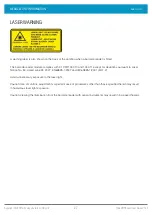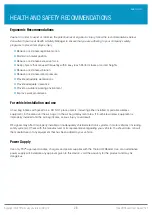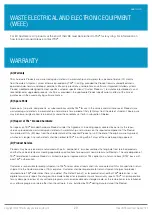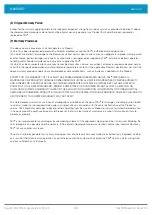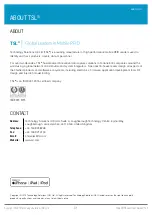
1166 UHF Reader User Guide V1.07
Copyright © 2019 Technology Solutions (UK) Ltd
25
INFORMATION TO THE USER – FCC
FCC warning statement:
This device complies with Part 15 of the FCC Rules.
Operation is subject to the following two conditions:
(1) This device may not cause harmful interference, and
(2) This device must accept any interference received, including interference that may cause undesired operation.
To comply with FCC RF exposure compliance requirements this unit must be operated in the hand with a
minimum separation of 20cm from the body and other persons. Other operating configurations should be avoided.
This unit must not be co-located or operated in conjunction with any other transmitter / antenna except those
already approved in this filing. Handheld configurations that provide no belt-clips or other body-worn accessories
and only transmit while in the hand and that maintain 20cm from the body, excluding hands, wrists, feet and
ankles, are allowed.
Changes or modifications not expressly approved by the party responsible for compliance could void the user’s
authority to operate the equipment
REGULATORY INFORMATION
RF EXPOSURE GUIDELINES
Safety information – To reduce RF exposure only use the device in accordance with the instructions supplied.
CANADIAN WARNING STATEMENTS
English
“Under Industry Canada regulations, this radio transmitter may only operate using an
antenna of a type and maximum (or lesser) gain approved for the transmitter by Industry
Canada.
To reduce potential radio interference to other users, the antenna type and its gain should
be so chosen that the equivalent isotropically radiated power (e.i.r.p.) is not more than that
necessary for successful communication.”
“This device complies with Industry Canada licence-exempt RSS standard(s). Operation is
subject to the following two conditions: (1) this device may not cause interference, and (2)
this device must accept any interference, including interference that may cause undesired
operation of the device.”
French
“Conformément à la réglementation d’Industrie Canada, le présent émetteur radio peut
fonctionner avec une antenne d’un type et d’un gain maximal (ou inférieur) approuvé pour
l’émetteur par Industrie Canada.
Dans le but de réduire les risques de brouillage radioélectrique à l’intention des autres
utilisateurs, il faut choisir le type d’antenne et son gain de sorte que la puissance isotrope
rayonnée équivalente (p.i.r.e.) ne dépasse pas l’intensité nécessaire à l’établissement
d’une communication satisfaisante.”
www.tsl.com

















